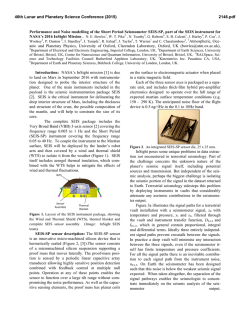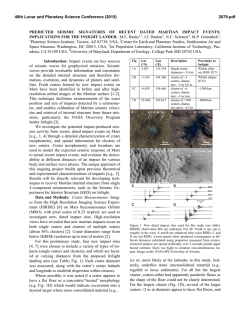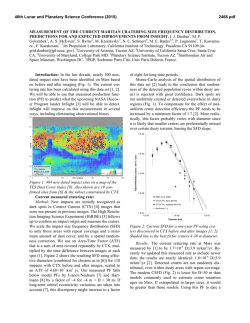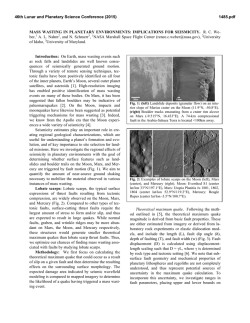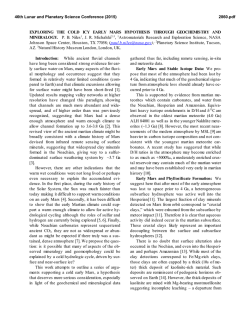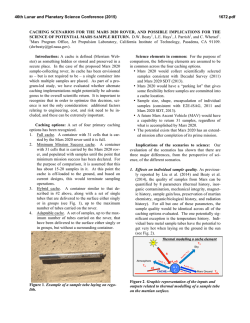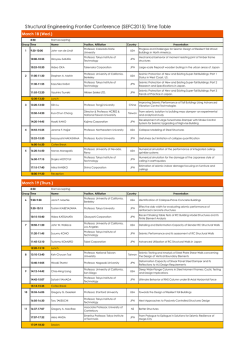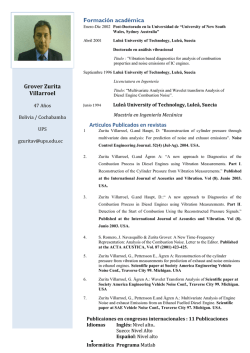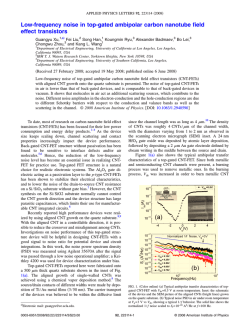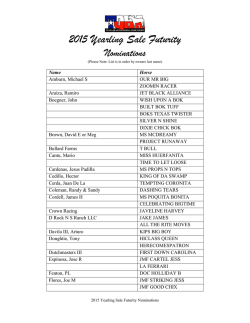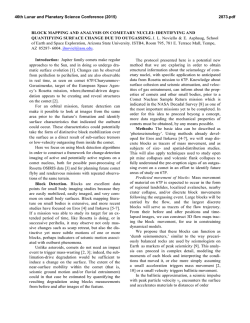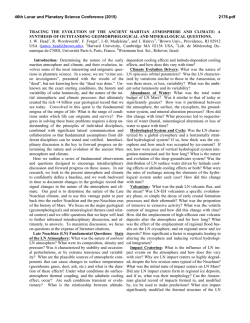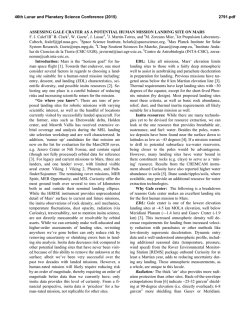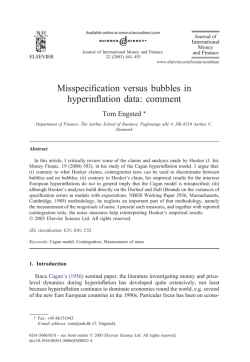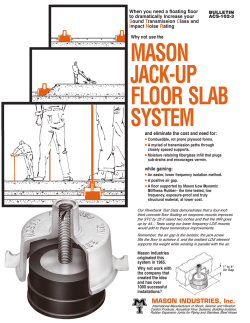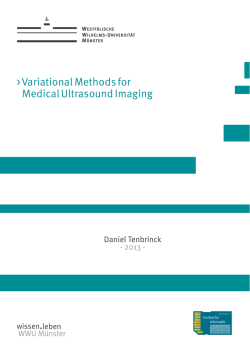
SCIENCE GOALS OF SEIS, THE INSIGHT SEISMOMETER
46th Lunar and Planetary Science Conference (2015) 2272.pdf SCIENCE GOALS OF SEIS, THE INSIGHT SEISMOMETER PACKAGE. P. Lognonné1, W. B. Banerdt2, R. C. Weber3, D. Giardini4, W. T. Pike5, U. Christensen6, D. Mimoun7, J. Clinton4, V. Dehant8, R. Garcia7, C. L. Johnson9,10, N. Kobayashi11, B. Knapmeyer-Endrun6, A. Mocquet12, M. Panning13, S. Smrekar2, J. Tromp14, M. Wieczorek1, E. Beucler12, M. Drilleau1, T. Kawamura1, S. Kedar2, N. Murdoch7, P. Laudet15 and the InSight/SEIS Team. (1) IPGP-Sorbonne Paris Cité, Univ. Paris, France Diderot ([email protected]) (2) JPL-Caltech, USA (3) NASA MSFC, USA (4) ETHZ, Switzerland (5) Imperial College, UK (6) MPS, Germany (7) ISAE, France (8) ORB, Belgium (9) UBC, Vancouver, Canada (10) PSI, USA (11) ISAS, Japan (12) LPGN, France (13) UFL, USA (14) Princeton, USA (15) CNES, France. Introduction: InSight (Interior Exploration using Seismic Investigations, Geodesy and Heat Transport) is the next Discovery mission, selected by NASA in 2012 [1]. It will be launched in March 2016 for a landing by the end of September 2016. Science operation will start in January 2017. The payload is a complete geophysical observatory, with a seismometer (SEIS), an heatflux experiment (HP3), a geodesy experiment (RISE), a magnetometer (IFG) and a suite of atmospheric sensors measuring wind, atmospheric temperature, and pressure. SEIS is the primary instrument of the mission and consists of a 3-axis very-broadband (VBB) instrument and a 3-axis short period (SP) instrument. Technology implementation: The SEIS sensor heads [2] will be installed 1-2 meters from the lander by a robotic arm and will be protected against thermal variations and direct wind effects on the sensor. Both the sensors’ expected performances and this installation will allow the detection of ambient seismic noise with amplitudes down to 10-9 m/s2/Hz½ (Figure 1). The key SEIS subsystems consist of the following, together with their lead institutions: VBB sensor head and sphere (IPGP, FR): Oblique 0.5 Hz seismometers with displacement transducers, located in a sphere under vacuum, sensitivity better than 10-9 ms-2/Hz1/2 in 0.01 – 2 Hz bandwidth [3]. SP sensors (IC, UK): 7 Hz short period seismometer with displacement transducers, 2 horizontal, one vertical, sensitivity better than 10-8 ms-2/Hz1/2 in 0.1 – 10 Hz bandwidth. SEIS acquisition electronics (ETHZ, CH): Performs 24-bit acquisition of all seismic channels. Leveling System (MPS, DE): Supports the VBB sphere and all the deployed sensors, levels the sphere to bring the VBB seismic sensors into their ideal dynamic range. Thermal Shield and tether (JPL, USA): Protect the sensing elements from the environment (wind, temperature extremes, thermal variations, etc.). The SEIS experiment is implemented and integrated by the French Space Agency, CNES. Figure 2 shows the different subsystems during the integration process. Science goals implementation: SEIS is expected to provide the first unambiguous seismic records of Mars. Thus implementation of the science goals is challenging due to the lack of information on the deep seismic interior structure of Mars, as well as the level of seismic activity and surface seismic noise. Figure 1: Comparison of the InSight seismometer requirement and capability (black solid and dotted lines, respectively) with those of previous Mars seismometers (red line, Viking 2, landed in 1976 [4]; blue line, Optimism on Mars96, lost in 1996 [5]). The improvement of the InSight requirement over the Viking capability is 1000× for body waves (1 sec) and 65000× for surface waves (20 sec), equivalent to 2 and 3.2 body wave (mb) and surface wave (ms) magnitudes respectively. In parallel to the technical implementation of SEIS, the science team has concentrated its efforts into three directions, associated with the challenges of: (i) single station seismic analysis, (ii) pre-launch estimation of the seismic and station generated noise, and (ii) pre-launch estimation of seismic sources other than quakes (for example, impacts). Pre-Launch single-station interior structure analysis: SEIS performance was tested against Earth analog signals recorded at the German Black Forest Observatory (BFO), where the signal-to-noise ratios of the records are close to the values expected for the 46th Lunar and Planetary Science Conference (2015) SEIS experiment on Mars [6]. By using the group arrival times of the first three orbits of the fundamental mode surface waves of earthquakes recorded at BFO, we demonstrated the capability to retrieve the origin time and epicentral distance of the events within the accuracy of the shortest period used in the surface wave analysis. Despite this low level of accuracy with respect to the much smaller errors in source location using standard network data on the Earth, body wave picks on relatively small datasets of 8 or 9 events were sufficient to permit the inversion for models of mantle velocity structure relatively close to the Earth reference model (PREM), even with very limited a priori knowledge of the expected seismic structure. In parallel with these efforts, the SEIS science team is also developing and implementing tools enabling the computation of seismic signals for realistic Mars interior models, including those taking into account the lateral variations in crustal structure and the interaction of the surface with the atmosphere. All these tools and approaches will be included in the Mars Data, Marsquake and Mars Structure Services, which will be implemented for the analysis and distributions of SEIS data, as part of the SEIS operation center (SISMOC). Pre-launch estimation of the instrument and station-generated noise: Due to the high sensitivity of the SEIS sensors, we expect the instrument noise to be mainly associated with (i) the interaction of the Mars environment with the instrument itself (e.g. thermal, thermo-elastic, magnetic and electric noise), (ii) the generation of surface deformation by the interaction of the lander with the Mars environment, and (iii) the interaction of the Mars surface with the Mars environment. This approach has led to a complete noise model, enabling better estimation of the expected SNR and operational constraints. Figure 3 illustrates a typical noise budget. Some of this noise can be reduced by using measurements taken by complementary sensors on the lander (especially for pressure and magnetic noise). Pre-launch estimation of the micro-seismic noise and amplitude of seismic signals from non-quake sources: The surface of Mars is expected to be continuously excited by atmospheric circulation and turbulence, and this interaction will be the primary and possibly the only source of micro-seismic noise. This noise will be detected by both the VBB and SP sensors, in three parts: (1) At long periods, quasi-static deformation of the surface, associated with wind-generated pressure waves. (2) At short periods, dynamic ground acceleration, associated with local and possibly regional trapped surface waves excited by wind dynamic pressure. 2272.pdf (3) At a global scale, a background hum resonating at Mars’ fundamental mode frequencies with unknown amplitude. We have developed models of this micro-seismic noise, from both ground models and global circulation models, which indicate that the seismic data will be able, particularly during the 6-8 most active hours of the day, to constrain the activity of the atmospheric boundary layer. Atmospheric noise levels are nevertheless expected to be very low during the night, and on the order of a few 10-9 m/s2/Hz1/2 during the day after environmental corrections. Figure 2: Photos showing the various SEIS subsystems along with the contributing country, during integration and tests activities at CNES-Toulouse (France). Figure 3: Typical noise budget for vertical and horizontal components of SEIS at 0.01 and 1 Hz under both day and night conditions. References: [1] Banerdt, W. B. et al. (2013) 44th LPSC Abstract #1915. [2] Lognonné, P. and Pike, W. T. (in press) Chapter in Extraterrestrial Seismology, Cambridge Univ. Press. [3] Dandonneau, P.-A. et al. (2013) 44th LPSC Abstract #2006. [4] Anderson, D. L. et al. (1977) JGR 82, 4524–4546. [5] Lognonné, P. et al. (1998) Planet. Space Sci. 46, 739–747. [6] Panning, M. P. et al. (2015) Icarus 248, 230–242.
© Copyright 2025
